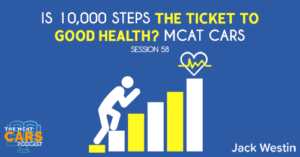
How much truth is really there in conventional wisdom? Today’s passage is focused on health, specifically around the 10,000-step goal. Where does this come from? Or is it only doing more harm than good? Jack Westin joins us again today for another dive into the world of MCAT CARS.
Listen to this podcast episode with the player above, or keep reading for the highlights and takeaway points.
Link to article:
https://www.theatlantic.com/health/archive/2019/05/10000-steps-rule/590785/
In America, the conventional wisdom of how to live healthily is full of axioms that long ago shed their origins. Drink eight glasses of water a day. Get eight hours of sleep. Breakfast is the most important meal of the day. Two thousand calories a day is normal. Even people who don’t regularly see a doctor are likely to have encountered this information, which forms the basis of a cultural shorthand. Tick these boxes, and you’re a healthy person.
In the past decade, as pedometers have proliferated in smartphone apps and wearable fitness trackers, another benchmark has entered the lexicon: Take at least 10,000 steps a day, which is about five miles of walking for most people. As with many other American fitness norms, where this particular number came from has always been a little hazy. But that hasn’t stopped it from becoming a default daily goal for some of the most popular activity trackers on the market.
Now new research is calling the usefulness of the 10,000-step standard into question—and with it, the way many Americans think about their daily activities. While basic guidelines can be helpful when they’re accurate, human health is far too complicated to be reduced to a long chain of numerical imperatives. For some people, these rules can even do more harm than good.
I-Min Lee, a professor of epidemiology at the Harvard University T. H. Chan School of Public Health and the lead author of a new study published this week in the Journal of the American Medical Association, began looking into the step rule because she was curious about where it came from. “It turns out the original basis for this 10,000-step guideline was really a marketing strategy,” she explains. “In 1965, a Japanese company was selling pedometers, and they gave it a name that, in Japanese, means ‘the 10,000-step meter.’”
Based on conversations she’s had with Japanese researchers, Lee believes that name was chosen for the product because the character for “10,000” looks sort of like a man walking. As far as she knows, the actual health merits of that number have never been validated by research.
In America, the conventional wisdom of how to live healthily is full of axioms that long ago shed their origins.
Jack says:
Axiom refers to truth that you don’t need proof for. It’s like a given truth that everyone accepts or knows. So this idea of how to live happily is being challenged here. They’re trying to figure out where this comes from.
Drink eight glasses of water a day.
Jack says:
This is probably an example of an axiom.
Get eight hours of sleep.
Jack says:
Here’s another example.
Breakfast is the most important meal of the day.
Jack says:
And another example. (Actually, this came from Kellog’s as part of their marketing campaign for one of their cereals.)
Two thousand calories a day is normal.
Jack says:
Here’s another idea.
Even people who don’t regularly see a doctor are likely to have encountered this information, which forms the basis of a cultural shorthand.
Jack says:
The author is saying that most people know this whether you go to a doctor or not. They’ve seen this information. “Cultural shorthand” means this is what we take for granted.
Tick these boxes, and you’re a healthy person.
Jack says:
It’s conventional wisdom. This is what you have to do to be a healthy person.
In the past decade, as pedometers have proliferated in smartphone apps and wearable fitness trackers, another benchmark has entered the lexicon: Take at least 10,000 steps a day, which is about five miles of walking for most people.
Jack says:
This is another new idea here. The pedometer is something that tracks your steps. In case you don’t know what this is, that’s okay. They tell you 10,000 steps a day so pedometer probably has something to do with metering or measuring your steps. It also says “wearable fitness tracker.”
As with many other American fitness norms, where this particular number came from has always been a little hazy.
Jack says:
We don’t really know where this came from (as well as the other fitness information out there.)
But that hasn’t stopped it from becoming a default daily goal for some of the most popular activity trackers on the market.
Jack says:
The author says it’s the norm now and it’s what is set as the goal. This paragraph is now giving us a specific example of an axiom.
Now new research is calling the usefulness of the 10,000-step standard into question—and with it, the way many Americans think about their daily activities.
Jack says:
Now, researchers are questioning this.
While basic guidelines can be helpful when they’re accurate, human health is far too complicated to be reduced to a long chain of numerical imperatives.
Jack says:
The author is saying that it’s great if we can’t be accurate. It’s helpful to have these guidelines. But human health is far too complicated to be reduced. It’s too complicated just to say 10,000 steps. Both the research and the author are saying this.
They stated this because they care about this and they want you to know this and that this is their point of view.
For some people, these rules can even do more harm than good.
Jack says:
The author is saying this is why we need to be accurate because it could be harmful.
I-Min Lee, a professor of epidemiology at the Harvard University T. H. Chan School of Public Health and the lead author of a new study published this week in the Journal of the American Medical Association, began looking into the step rule because she was curious about where it came from.
Jack says:
We’re given this author of the study who’s trying to look into this.
“It turns out the original basis for this 10,000-step guideline was really a marketing strategy,” she explains.
Jack says:
It’s all marketing (going back to how breakfast is the most important meal of the day).
“In 1965, a Japanese company was selling pedometers, and they gave it a name that, in Japanese, means ‘the 10,000-step meter.’”
Jack says:
This Japanese company made pedometer called the 10,000-step meter and this is where we got this rule.
Based on conversations she’s had with Japanese researchers, Lee believes that name was chosen for the product because the character for “10,000” looks sort of like a man walking.
Jack says:
We’re given more backstory of this.
As far as she knows, the actual health merits of that number have never been validated by research.
Jack says:
The point of this passage is that a lot of these ideas we have, or like the conventional wisdom we have, are not research-based. They’re really focused on the 10,000-step idea.
This is what the author is calling into question. But we don’t know for sure if it’s going to harm you or do a thing for you. It’s not just measured. We don’t know so just take it with a grain of salt.
A good question the MCAT may post is which of the following assertions is not supported by the passage. A good one would be that it does more harm than good. Because that’s not supported. They bring it up at the very end of the paragraph, but they don’t elaborate on it. They don’t talk about it anymore in the next paragraph.
Hence, make sure to pick an answer that was not discussed or isn’t supported at all.
Link to article:
https://www.theatlantic.com/health/archive/2019/05/10000-steps-rule/590785/

Lorem ipsum dolor sit amet, consectetur adipiscing elit
I just received my admission to XXXXX! This is unreal and almost feels like I am dreaming. I want to thank you for all of your help with my application. I cannot overstate how influential your guidance and insight have been with this result and I am eternally grateful for your support!
IM SO HAPPY!!!! THANK YOU SO MUCH FOR ALL YOUR HELP, IM INDEBTED TO YOU! Truly, thank you so much for all your help. Thank you doesnt do enough.
I want to take a few moments and thank you for all of your very instructive, kind and consistent feedback and support through my applications and it is your wishes, feedback, and most importantly your blessings that have landed me the acceptance!
I got into XXXXX this morning!!!! It still has not hit me that I will be a doctor now!! Thank you for all your help, your words and motivation have brought me to this point.
I wanted to once again express my heartfelt gratitude for your help in providing feedback during my secondary applications. Your guidance has been instrumental in my journey.
Just wanted to share my wonderful news! I received my first medical school acceptance! Thank you for all that you do for us Application Academy!!!
I am excited to tell you that I just got my third interview invite from XXXXX today! I can’t believe it. I didn’t even know if I was good enough to get one, let alone three – by mid-September. Thank you so much for all of your help and support up to this point; I would not be in this position without it!!
I wanted to thank you for helping me prepare for my XXXXX interview. Even in a 30-minute advising session, I learned so much from you. Thank you for believing in me, and here’s to another potential success story from one of your advisees!
I just received an acceptance with XXXXX! This is so exciting and such a huge relief and so nice to have one of our top choice schools! I also received an interview with XXXXX which brings the total up to 20 interviews! Thank so much, none of this would have been possible without you!

Join our newsletter to stay up to date
* By subscribing you agree to with our Privacy Policy and provide consent to receive updates from our company.
Resources
Advising Services
Podcasts & Youtube
Books
About
Deal Lasts for
